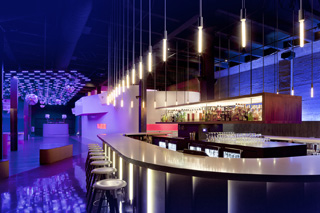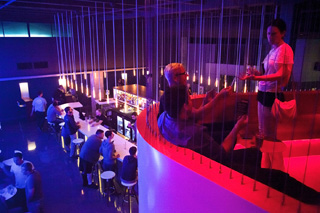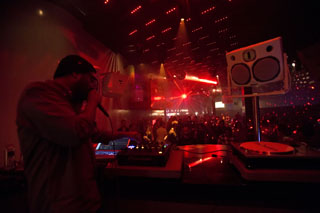|
Subscribe / Renew |
|
|
Contact Us |
|
| ► Subscribe to our Free Weekly Newsletter | |
| home | Welcome, sign in or click here to subscribe. | login |
Architecture & Engineering
| |
April 10, 2013
Project of the Month: Q Nightclub: ‘Shock and awe’ design for grungy Seattle
Special to the Journal
The nightclub called Q stands out — literally — at Broadway and Pike. There’s a full-height fin on one side of the entrance. It’s an extension of a long arcing wall of the same electric green color that leads from the street into the beating heart of the club.
Along with the crowds, it’s all there: pulsing motion and music, lights and color, and lots of bottles and glasses. But there’s something else: an investment in really smart design.
Are we really in Seattle?
“Seattle is great with dive bars, the grungy, relaxed atmosphere,” said Q Nightclub co-owner Andrew Rampl, who started Q as managing partner with Scott Smith, former owner of XL, an exclusive club in New York. “There are not that many places where people can dress up or just come as they are (after work),” said Rampl.
So they did research. Rampl said he and Smith were convinced that Seattle’s club crowd was tired of “sitting on broken furniture that reeks of beer.” Maybe they were looking for something with a little more glamour.
So what were the owners looking for with the design? “Shock and awe,” Rampl said.
Bohlin Cywinski Jackson delivered. The firm is celebrated for its work, from single-family homes to cultural institutions. BCJ had never designed a club, but that was OK with the owners of Q.
“For decades, the firm had been pursuing the goal of creating great places for people to hang out and socialize,” said BCJ principal Robert Miller. The project was a creative challenge.
Q Nightclub is a little bit New York, but it resonates with others in cities around the globe where nightlife is taken seriously and enjoyed in splashy surroundings, on the dance floor, or with drink and talk.
| Q Nightclub 1426 Broadway |
|
Bohlin Cywinski Jackson Peter Q. Bohlin, principal Robert Miller, principal Ray Calabro, principal Nate Lambdin, project manager Other team members include Patreese Martin, Emma Nowinski, Matt Wittman, Kyle Phillips Owner: FMJ Clubcorp LLC Project type: Tenant improvement and structural retrofit Size: 9,000 square feet Completion: September 2012 Structural engineer: PCS Structural Solutions Bar consultant: Batali Associates Lighting consultant: SJ Lighting Sound consultant: Sound Investment General contractor: Dovetail General Contractors |
One of the first decisions was no kitchen. “The nightclub lives by selling drinks,” said Rampl.
Drinks are served with a heady environment. The drama begins in the entry, which is open to the rafters of what was once an automotive service center. The arc of the tall corridor seems to go on forever because it ends in a mirror wall that contains a ticketing counter. With a turn to the left, the freestanding bar — an island of glass, light, color and motion — explodes into view.
To the left again, the dance floor pulses on weekend nights, with a complex array of lighting and speakers both overhead and near the floor. At the back of the dance floor is a raised stage with a thicket of electronics. It’s a stage for the reigning star — the DJ — who moves busily in full view of much of the club. Beyond that, is a more intimate barroom that serves artisan whiskeys.
There are intriguing niches and drink surfaces as counterpoints, out of the mainstream of movement, for couples and small groups to perch.
The mezzanine above is also a retreat and a lookout. There are plenty of prospect points at Q for scoping the crowd.
“The bones of any nightclub are here,” said Rampl.
From the long entry sequence to the focal bar to the whiskey bar in back — which is actually against the outer wall along Broadway — there are many distinct spaces inside Q.
But along with the drinks, space flows easily. A wide passage running along the back wall connects the two bars and leads to restrooms and a stairway to the mezzanine.
“People can do loops around the club,” said BCJ project manager Nate Lambdin.
At its heart, a torpedo
The real force in the floor plan is an enclosed one-story volume in the center that the architects call The Torpedo. “It became the defining solid form in the space,” said BCJ principal Ray Calabro.
With rounded and glossy walls, it holds restrooms and storage. The mezzanine is on top.
Through the heart of The Torpedo a tubular stairway leads up to the mezzanine lounge. Right overhead emerging from the stairs is the shock of the old: the preserved timber superstructure of a garage high overhead in a shaft. The crossed sticks of a glowing light sculpture set off the rough timbers.
Built-in furnishings and tables provide coveted seating, as well as places to stand and ledges for holding a glass while taking in the scene below. A screen that bounds the curving walls behind the seating doubles as a rail.
Restrooms are not an afterthought at Q. Situated right next to the mezzanine stairs, much of the typical restroom space is taken up by a unisex mixing area. There are few sharp corners. Individual toilet rooms contain everything necessary, and more: shelf space and hooks, mirrors, a sink.
Once the basic concept and plan for Q had been hammered out, everything became part of the design: lighting and sound, logo and signage, menus — even bottles.
“It was all very collaborative,” said Calabro.
Q has many lives
Like many clubs of this type, Q serves up mostly drinks and electronic dance music. But on slower weekday nights, the program shifts to suit special tastes. “We’re looking into a live jazz night on Tuesdays,” said Rampl.
“Seattle doesn’t like the VIP thing,” he said, “but then there’s a customer base that wants that. If someone wants a VIP party we offer it.”
It’s adaptable. A “soft wall” closes off the dance floor for slow nights, and the bar can still serve as the focal point. The partition can be configured differently to wall off parts of the venue and make the place seem full even when it is not. “By design, you don’t have the energy suck of an empty space,” said Rampl.
During the week Q is more of an after-restaurant meeting place — more craft drinks, more customer interaction. “Friday and Saturday it becomes a beast,” he said. That means simple, fast drinks — and as many people as possible.
But Q has many lives. Mats are spread on the dance floors for yoga sessions on some days — with a DJ.
It’s even part of the civic life of Capitol Hill. Last fall, it was the venue for an official election night voting party. Attendees filled out their ballots inches from the bar — which was actually on the other side of a soft wall deployed for the purpose.
But in the end, a nightclub is a business, and business rules apply. With a flourish of praise, Rampl declared Q “on time, on budget.”
Jury comment:
“Q Nightclub bumps the glitz of expected nightclub trappings into refined demarcations of line and volume. It’s theatrical and formal at the same time. If you emptied the place out, the spatial arrangements would be just as loud and seductive.”
The Project of the Month is sponsored by the Daily Journal of Commerce and the Seattle chapter of the American Institute of Architects. The Project of the Month was selected with the assistance of architect Jane Hendricks, artist Mary Ann Peters and developer Chris Rogers. To learn about how to submit your project, contact Joan Hermann at AIA Seattle at joanh@aiaseattle.org.
Clair Enlow can be reached by e-mail at clair@clairenlow.com.
Previous columns:
- Project of the Month: ‘Question everything': Federal Way cuts school costs — a lot, 03-13-2013
- Project of the Month: OKA's [storefront]: An experiment becomes essential, 02-06-2013
- Project of the Month: Exceptional design calms the chaos of a student fitness center, 12-05-2012
- Project of the Month: Greenbridge in White Center has a kid-friendly heart, 11-07-2012
- Project of the Month: Suburban school with a Zen garden at its heart, 10-03-2012
- Project of the Month: Modern building set inside a treasured shell, 09-12-2012
- Project of the Month: Duplex designers are also swinging the hammers, 08-15-2012
- Project of the Month: NSCC job center changing lives — inside and out, 07-25-2012





